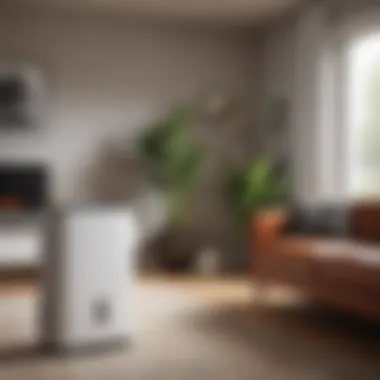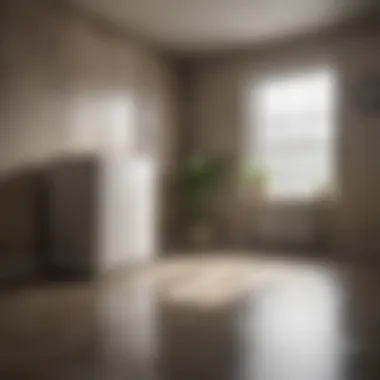Using Dehumidifiers Effectively to Prevent Mold Growth


Intro
Mold is a persistent issue in many homes, thriving in damp, humid environments. Its presence can lead to health risks and structural concerns, making it imperative for homeowners to take preventive measures. One effective way to combat mold is through the use of dehumidifiers, devices that help regulate indoor humidity levels.
In this article, we will explore how dehumidifiers function as a robust solution for managing mold growth. We will discuss the relationship between humidity and mold, delve into the science behind mold types, and provide guidelines on choosing the best dehumidifier for your space. The goal is to arm readers with knowledge and practical strategies to enhance indoor air quality and ensure a mold-free environment.
Understanding why and how mold proliferates allows homeowners not only to effectively combat it but also to create a healthier living space. This comprehensive guide will empower readers to harness the power of dehumidifiers as a long-term strategy in maintaining optimal humidity and preventing mold growth.
Understanding Mold Growth
Mold is ppart of our everyday environment, often unnoticed until it becomes a problem. Understanding mold growth is crucial for anyone interested in keeping indoor air quality high and their home free from health hazards. This part of the article lays the foundation for why dehumidifiers can be an essential tool in managing mold.
Mold thrives in environments that provide moisture, warmth, and nutrients. When these conditions are present, mold can colonize rapidly, leading to various health risks and structural damage to a home. By recognizing how mold operates, homeowners can take proactive steps to mitigate risks associated with its growth.
The Biology of Mold
Mold belongs to the fungus kingdom. Unlike plants, molds do not photosynthesize; they depend on organic matter for nourishment. It reproduces by releasing tiny spores into the air. These spores can travel long distances and can germinate when they land on a damp surface. Understanding the biological mechanisms of mold helps in formulating strategies against it, especially in relation to humidity control.
Common Types of Mold Found at Home
Stachybotrys chartarum (Black Mold)
Stachybotrys chartarum, commonly known as black mold, is one of the most feared types of mold found in homes. This mold is notorious for producing mycotoxins that can lead to serious health issues. Its key characteristic is that it thrives in moist conditions, particularly where there is a source of cellulose, such as wood or paper.
Black mold is often a concern because its presence can indicate prolonged moisture problems. Its unique feature is its dark appearance, often resulting from a slimy texture when wet. Addressing black mold requires immediate attention to moisture sources, making it crucial to implement dehumidification strategies to prevent re-growth.
Aspergillus
Aspergillus is another common mold type, known for its varied appearance and growth conditions. It can thrive in indoor environments without excessive moisture but is more aggressive when humidity levels are elevated. Aspergillus species contribute to allergic reactions and respiratory issues in sensitive individuals.
Its unique feature is its ability to grow on a diverse range of surfaces, including food. Aspergillus can be particularly problematic in kitchens and storage areas. For this reason, controlling humidity is essential to limiting its proliferation, ensuring healthier living conditions.
Cladosporium
Cladosporium is found both indoors and outdoors, making it a prevalent mold type. It can grow on painted surfaces and carpets, and thrives in damp areas. This mold is often overlooked, but it can cause allergic reactions for some people, leading to respiratory problems.
The key characteristic of Cladosporium is its woolly texture on surfaces where it grows. It requires moderate moisture, often at higher levels than other molds, making the dehumidifiers a useful tool in managing its presence.
Penicillium
Penicillium is a mold commonly found indoors and is known for its blue or green appearance. While some Penicillium species are beneficial, notably in antibiotic production, others can cause health issues, particularly in individuals with respiratory conditions.
Its unique feature is its rapid growth, which can occur even at lower humidity levels. This characteristic means that mold prevention strategies need to be robust to address this potential threat.
Conditions Favoring Mold Growth
Humidity Levels
High humidity levels are the primary contributor to mold growth. When relative humidity exceeds 60%, mold spores can germinate. Monitoring and controlling humidity is vital in preventing mold from taking hold in your home. Maintaining lower humidity levels promotes a drier environment, essential for mold management.
Temperature Ranges
Mold thrives in warm environments, ideally between 77°F and 86°F (25°C to 30°C). These temperatures are favorable for many types of mold. Awareness of indoor temperatures can help manage conditions that may lead to mold growth, particularly in regions with climates that promote high temperatures.
Poor Ventilation
Poor ventilation is another condition that promotes mold growth. Areas that do not exchange air efficiently retain moisture, providing an ideal environment for mold. Implementing strategies that improve air circulation can help reduce humidity and prevent stagnation, decreasing the likelihood of mold development.
Understanding and addressing the conditions that favor mold growth provides homeowners with the tools to maintain a healthier environment. Using dehumidifiers effectively plays an essential role in managing these factors.
The Role of Humidity in Mold Development
Understanding how humidity affects mold growth is crucial in the fight against mold in homes. Higher levels of humidity create a favorable environment for mold to thrive. Therefore, controlling humidity becomes a significant factor in preventing mold infestations.
Humidity, measured as relative humidity, defines the amount of moisture in the air compared to the maximum amount the air can hold at a given temperature. When relative humidity exceeds 60%, it can encourage mold spores to germinate and grow. This article will delve into relative humidity, how it influences mold growth, and methods for identifying humidity levels in your home.


Understanding Relative Humidity
Relative humidity is essential for determining indoor air quality. It represents how saturated the air is with moisture. For example, if the relative humidity is at 70%, the air is holding 70% of the moisture it can sustain at a specific temperature.
Low humidity levels, typically below 30%, can lead to dry air that may cause discomfort, including respiratory issues and skin irritation. On the other hand, high humidity levels are ideal for mold growth. The recommended indoor relative humidity range is between 30% and 50%, which maintains comfort and minimizes mold proliferation. Homeowners should regularly monitor these levels to ensure they remain in a safe range.
How Humidity Influences Mold Growth
The relationship between humidity and mold growth is direct. When humidity levels increase, the risk of mold formation rises significantly. Mold spores are everywhere, but they need the right conditions to settle and reproduce.
Several factors contribute to how humidity influences mold growth:
- Moisture Availability: High humidity results in water collecting on surfaces, which provides the necessary moisture for mold.
- Spores: Certain humidity levels can trigger dormant mold spores to wake up and start growing.
- Surface Conditions: Porous materials, like wood and drywall, absorb moisture, making them prominent hosts for mold.
In essence, whenever humidity levels are elevated, homeowners must take precautions to reduce potential mold growth.
Identifying Humidity Levels in Your Home
To tackle mold issues effectively, it is vital to know your home's humidity levels. Here are some methods to identify them:
- Hygrometers: These simple devices measure relative humidity effectively. Place them in different rooms to get a comprehensive view of your home's conditions.
- Visual Indicators: If you notice condensation on windows or walls, this may indicate high humidity. Look for other signs like peeling paint or a musty odor, as these may suggest excess moisture.
- Seasonal Changes: Monitor humidity changes with seasons. Humidity tends to be higher in summer and lower in winter, so adjustments may be necessary based on the time of year.
By understanding these elements, homeowners can become proactive in managing indoor humidity levels, substantially reducing the likelihood of mold growth.
Choosing the Right Dehumidifier
Selecting the appropriate dehumidifier is crucial for effectively combating mold in your home. The right unit helps maintain optimal humidity levels, which is essential for preventing mold growth. Different types of dehumidifiers offer various features and benefits. Understanding these can guide homeowners in making an informed decision.
Types of Dehumidifiers
Refrigerant Dehumidifiers
Refrigerant dehumidifiers work by cooling air to extract moisture. They rely on a refrigerant system similar to a refrigerator. This type is effective in climates with high humidity. A key characteristic is their ability to lower moisture significantly. Refrigerant units are popular because they can handle larger spaces. However, they may not perform as well in lower temperatures. When considering for mold, they can be very beneficial in warm areas.
Advantages:
- Suitable for large areas
- Effective in humid climates
- Generally have a larger capacity
Disadvantages:
- Less effective in cold temperatures
- Can be noisy compared to other types
Desiccant Dehumidifiers
Desiccant dehumidifiers use materials that absorb moisture from the air. They do not rely on cooling systems. A main feature is their efficiency in lower temperatures. They are an excellent choice for basements or areas with low temperatures. This makes them popular for mold control during colder months. They also tend to operate quieter than refrigerant units.
Advantages:
- Work well in cooler environments
- Quieter operation
- Can be more portable
Disadvantages:
- Often have a lower moisture removal capacity
- Can consume more energy over time
Electric vs. Non-Electric Units
When choosing a dehumidifier, consider whether you want an electric or non-electric unit. Electric dehumidifiers are standard and rely on power to operate. Non-electric options include solar-powered or manual units, somewhat more sustainable.
Electric dehumidifiers provide consistent performance, making them reliable for continuous use. They offer features like automatic shutdown and humidity sensors. Non-electric units are suitable for small areas, where power may be a concern. They are eco-friendly and reduce energy costs but require manual maintenance.
Advantages of Electric Units:
- Continuous operation with no manual labor required
- Advanced features for automation
Advantages of Non-Electric Units:


- Environmentally friendly
- Cost-effective in low usage situations
Capacity Considerations
When assessing dehumidifiers, consider the unit’s capacity, measured in pints of moisture removed per day. The capacity should match the area size. A larger capacity is beneficial for larger rooms or spaces with high humidity.
Energy Efficiency Ratings
Look for energy-efficient models to minimize electricity bills. Check for Energy Star ratings when selecting a dehumidifier. These units not only save money but also reduce environmental impact.
"Selecting an effective dehumidifier is not just about managing humidity; it's about safeguarding your indoor environment against mold and its health risks."
Make sure to evaluate your specific needs, including room size and humidity levels before making a purchase.
Effective Use of Dehumidifiers to Combat Mold
The effective use of dehumidifiers is critical in managing mold growth within homes. Mold thrives in damp environments, making humidity control essential. Dehumidifiers offer a solution to lower humidity levels, thus creating an unfavorable environment for mold spores. By utilizing these devices properly, homeowners can significantly reduce the likelihood of mold infestations, improve indoor air quality, and protect their property.
Optimal Placement of Dehumidifiers
Placement of dehumidifiers is important for their efficacy. When setting up a dehumidifier, consider areas that are prone to moisture. These typically include basements, bathrooms, and laundry rooms.
While placing a dehumidifier, follow these guidelines:
- Central Location: Position the unit in a central area where humidity tends to accumulate.
- Avoid Obstacles: Ensure that air intake and output are not obstructed by furniture or walls.
- Close to Moisture Sources: If possible, place the unit near areas with frequent moisture, like bathrooms or kitchens.
This strategic placement enhances the ability of the dehumidifier to absorb excess moisture quickly and efficiently. Moreover, keep doors and windows closed when operating the device to maximize its effectiveness.
Daily Operation and Maintenance
Daily operation of your dehumidifier should be routine for best results. Maintain a consistent setting to regulate humidity levels effectively. Monitor the humidity levels in your home using a hygrometer, aiming for a range between 30-50% for optimal indoor air quality.
Regular maintenance is equally essential. Follow these steps to keep your dehumidifier functioning well:
- Check the Water Tank: Empty it regularly to prevent overflow and ensure continuous operation.
- Clean or Replace Filters: Follow the manufacturer’s guidelines on filter maintenance to enhance performance.
- Inspect Coils: Make sure evaporator and condenser coils are clean and free from dust.
Routine checks of your unit can help prevent issues that may lead to inefficiency. An efficiently running dehumidifier plays a significant role in combatting mold by maintaining the right moisture levels in the home.
"Dehumidifiers help create an environment that's less conducive to mold growth, thus protecting your home and health."
By understanding how to effectively use and maintain dehumidifiers, you position yourself to significantly mitigate mold risks in your living spaces. Iit requires diligence and consistency, but the payoff is a healthier and safer home.
Preventative Measures Beyond Dehumidification
While dehumidifiers play a significant role in managing mold, they are just one part of a larger strategy. The importance of supplementary preventative measures cannot be overstated. Together with dehumidification, these strategies create a comprehensive approach to mold management in homes. They address the root causes of mold growth, ensuring that your indoor environment remains healthy and mold-free.
Improving Home Ventilation
Proper ventilation is essential in any home, particularly in areas prone to high humidity. Ventilation helps to circulate air, reducing moisture levels and altering the conditions mold thrives in. Installing exhaust fans in kitchens and bathrooms can efficiently remove excess humidity produced from cooking or showering. It's important to ensure that these systems are functional and regularly cleaned to maintain efficiency.
Additionally, opening windows during dry days can promote air exchange, further lowering indoor humidity. This practice can be especially beneficial for attics and basements, which often trap moisture. Letting in fresh air helps to dilute indoor pollutants and moisture.
Regular Cleaning Practices
Cleaning is a fundamental practice that can mitigate mold growth. Regular removal of dust and debris also minimizes surfaces for mold spores to adhere. Focus on moist areas, such as bathrooms and kitchens. Use a mixture of water and detergent for general cleaning, but for more persistent mold, a diluted bleach solution may be necessary.
Highlighting the significance of routine inspections in hidden areas like under sinks and behind appliances can help in early detection of mold. Employing this practice prevents small infestations from evolving into larger issues. Mold can easily spread if left unchecked, so proactive cleaning helps in maintaining a mold-free home.
Using Mold-Resistant Materials
When building or renovating, consider using mold-resistant materials. Products such as mold-resistant drywall, paints, and insulation can significantly decrease the potential for mold growth. For example, gypsum boards are specifically constructed with mold-resistant properties, making them less hospitable to mold spores.
Laminate flooring is another option, as it can withstand moisture better than traditional wood. It’s also beneficial to apply mold-resistant sealants in areas that are frequently exposed to water. Investing in these materials may have higher upfront costs, but the long-term benefits of reducing mold risk can lead to significant savings in remediation and health expenses.
Proper ventilation, regular cleaning, and using mold-resistant materials create a robust defense against mold, adding layers of protection beyond dehumidification.
By implementing these preventative measures, homeowners can enhance their indoor air quality and create an environment less conducive to mold development. A focused strategy combining these methods with the use of dehumidifiers ensures a comprehensive approach to mold management.


Addressing Existing Mold Issues
Addressing existing mold issues is an essential component of ensuring a safe and healthy living environment. Mold can cause various health problems, especially in vulnerable individuals. Recognizing the seriousness of a mold infestation is the first step toward mitigating its effects. The presence of mold may indicate underlying moisture problems that need immediate attention. By systematically identifying and addressing these issues, homeowners can significantly reduce health risks and improve indoor air quality.
Identifying Mold Infestations
Identifying mold infestations is critical for effective mold management. Mold can grow in various places, making it easy to overlook initially. Areas commonly prone to mold include basements, bathrooms, and places with poor ventilation. Homeowners should inspect for signs of mold such as discoloration on walls, musty odors, and visible patches of mold growth. Utilizing a flashlight to inspect dark corners can reveal hidden infestations.
To confirm if what you see is indeed mold, a simple rule is to look for its typical colors—green, black, or white. Mold thrives on wet surfaces, so checking bathroom tiles, the underside of sinks, and around window frames is advisable. Immediate action must be taken once an infestation is confirmed, as mold can spread quickly if left untreated.
Safe Removal Techniques
When it comes to removing mold, safety must be a priority. Following safe removal techniques helps avoid further contamination and enhances personal safety.
Personal Protective Equipment
Personal Protective Equipment (PPE) is essential during mold removal. This equipment includes gloves, goggles, and masks. The key characteristic of PPE is its ability to shield individuals from mold spores, which can trigger allergic reactions and respiratory issues. It is a beneficial choice in scenarios where a person may be exposed to high levels of mold.
A unique feature of PPE is its adaptability to different types of mold situations. For instance, while basic masks can suffice for small patches of mold, industrial-grade respirators are much better for larger infestations. The main disadvantage, however, is the discomfort some may feel while wearing it for extended periods.
Cleaning Solutions
Choosing appropriate cleaning solutions is vital for effectively eliminating mold. Common solutions include vinegar, hydrogen peroxide, and commercial mold removers. The main characteristic of these solutions is their ability to kill mold spores and prevent further growth. They are generally regarded as effective and safe choices in this context.
A unique feature of vinegar is its non-toxic nature, making it suitable for households with children or pets. This is an advantage in promoting a safer indoor environment. However, some may find its smell off-putting, which can be seen as a disadvantage.
In summary, identifying mold infestations and employing safe removal techniques are critical steps in managing existing mold issues. Personal Protective Equipment and effective cleaning solutions play a significant role in this process. Addressing these issues promptly not only benefits the living space but also contributes to overall health and well-being.
Monitoring Indoor Air Quality
Monitoring indoor air quality is crucial for maintaining a healthy and comfortable living environment. It involves tracking various factors that contribute to the overall air quality in a home, particularly humidity and mold spore levels. Households with high humidity or poor air quality may experience various health issues, such as allergies, respiratory problems, and other ailments. Therefore, keeping tabs on indoor air quality not only enhances the comfort of living spaces but also protects the health of the inhabitants.
Regular monitoring allows for the timely identification of issues. It helps homeowners understand the effectiveness of their dehumidifiers and shows when adjustments might be necessary. By being proactive about indoor air quality, you can reduce the chance of mold proliferation and maintain a pleasant atmosphere in your home.
Using Humidity Monitors
Humidity monitors are essential tools for tracking moisture levels in your home. These devices provide real-time data, enabling homeowners to make informed decisions about their indoor environment. Ideal humidity levels typically range between 30% to 50%. When humidity exceeds this range, mold growth can become a pressing concern.
There are several types of humidity monitors:
- Analog hygrometers: Simple, easy-to-read devices.
- Digital hygrometers: Offer precise measurements and additional features like temperature displays.
- Smart hygrometers: Connect to Wi-Fi or Bluetooth to provide data via smartphone apps.
Using these monitors allows for adjustments to be made before problems escalate. For example, if humidity levels remain consistently high, this is a prompt to increase the use of a dehumidifier or improve ventilation in affected areas.
Assessing Mold Spore Levels
Assessing mold spore levels is another significant aspect of indoor air quality management. High levels of mold spores can lead to health issues, especially for individuals with sensitivities or pre-existing conditions. Regular testing can help identify hidden mold problems and the best strategies to combat them.
Methods for assessing mold spore levels include:
- Air sampling: Collecting air samples to analyze for spore concentration.
- Surface sampling: Testing specific areas suspected of mold presence.
- Mold testing kits: Available for homeowners to conduct their own assessments.
Monitoring mold spore levels is vital for understanding the effectiveness of your dehumidification efforts. If mold spores are still prevalent despite using dehumidifiers, it’s essential to investigate potential sources of moisture entry or lingering mold issues. Keeping track of these factors plays a key role in maintaining good indoor air quality.
Finale
In this article, we examine the critical role of dehumidifiers as a tool to manage mold growth in residential environments. The importance of maintaining optimal humidity levels cannot be overstated when considering the prevention and control of mold. High humidity levels foster an environment conducive to mold proliferation. By using dehumidifiers, homeowners can effectively reduce excessive moisture, creating conditions less favorable for mold.
The benefits of utilizing dehumidifiers extend beyond merely the reduction of mold growth. They contribute to a healthier indoor air quality and improved comfort in living spaces. This is especially relevant for those susceptible to allergies or respiratory problems. Moreover, selecting the right dehumidifier and using it properly can lead to long-term solutions against persistent mold issues.
When considering the effectiveness of dehumidifiers in combating mold, it is essential to evaluate several factors. These include the size of the area needing treatment, energy efficiency, and the type of dehumidifier best suited to the environment. Regular maintenance and monitoring of humidity levels play a decisive role in ensuring these devices work effectively. It is not just about having a dehumidifier; it is about how it fits into a broader mold management strategy.
Summary of Key Points
- Humidity Control: High humidity fosters mold growth; controlling humidity levels is crucial.
- Types of Dehumidifiers: Different types are available, including refrigerant and desiccant models, making careful selection important based on individual needs.
- Optimal Operation: Placement and regular maintenance are critical to ensure effective operation and prolonged lifespan of the unit.
- Preventative Measures: Alongside dehumidification, improving ventilation and using mold-resistant materials are effective in managing mold risks.
Final Thoughts on Mold Management
Monitoring and controlling humidity levels with dehumidifiers can significantly reduce the likelihood of mold infestations. It is a proactive approach that complements other mold management strategies. Homeowners should not underestimate the importance of regular assessments of indoor conditions. By combining the usage of dehumidifiers with good cleaning practices and proper ventilation, it is possible to create a healthier and more comfortable living space. Taking decisive actions against mold growth ensures the longevity and safety of one’s home.
"An environment controlled for humidity is a step towards a mold-free home."



